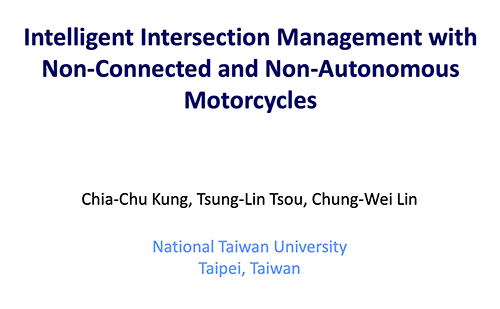Intelligent Intersection Management with Non-Connected and Non-Autonomous Motorcycles
Submitted by Qi Zhu
on
Chung-Wei Lin received the B.S. degree in computer science and information engineering and the M.S. degree in electronics engineering from National Taiwan University, Taipei, Taiwan, and the Ph.D. degree in electrical engineering and computer sciences from the University of California at Berkeley, Berkeley, CA, USA. He is currently an Assistant Professor with the Department of Computer Science and Information Engineering, National Taiwan University. His research interests include cyber-physical systems, connected and autonomous vehicles, security, system design methodology, and model-based design.
ABSTRACT

View Slides | Download
Intelligent intersection management is a very representative application of connected and autonomous vehicles, and there have been many related works from different perspectives. However, motorcycles have not yet been considered in intelligent intersection management, and this is a crucial problem for certain places, especially those with high population densities. In this paper, we consider motorcycles and identify the fundamental differences from existing intelligent intersection management. Considering the features of motorcycles, we propose to use "grouping" and "two-phase left turns with waiting zones" for motorcycles to improve the traffic efficiency of an intersection where vehicles are connected and autonomous and motorcycles are non-connected and non-autonomous. To the best of our knowledge, this is the first work in the literature to model and study the intelligent intersection management with motorcycles. Our case study demonstrates essential trade-offs and insights for designing intelligent intersection management with motorcycles.
Chung-Wei Lin received the B.S. degree in computer science and information engineering and the M.S. degree in electronics engineering from National Taiwan University, Taipei, Taiwan, and the Ph.D. degree in electrical engineering and computer sciences from the University of California at Berkeley, Berkeley, CA, USA. He is currently an Assistant Professor with the Department of Computer Science and Information Engineering, National Taiwan University. His research interests include cyber-physical systems, connected and autonomous vehicles, security, system design methodology, and model-based design.
ABSTRACT
| View Slides | Download |
Intelligent intersection management is a very representative application of connected and autonomous vehicles, and there have been many related works from different perspectives. However, motorcycles have not yet been considered in intelligent intersection management, and this is a crucial problem for certain places, especially those with high population densities. In this paper, we consider motorcycles and identify the fundamental differences from existing intelligent intersection management. Considering the features of motorcycles, we propose to use "grouping" and "two-phase left turns with waiting zones" for motorcycles to improve the traffic efficiency of an intersection where vehicles are connected and autonomous and motorcycles are non-connected and non-autonomous. To the best of our knowledge, this is the first work in the literature to model and study the intelligent intersection management with motorcycles. Our case study demonstrates essential trade-offs and insights for designing intelligent intersection management with motorcycles.